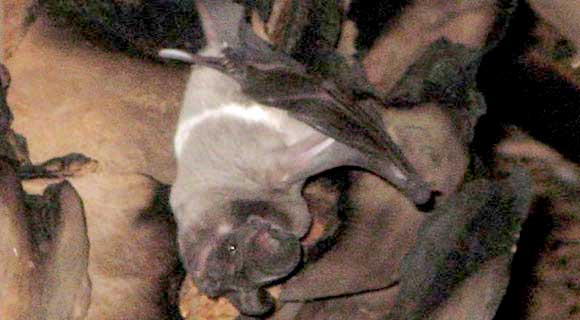FWC’s Endangered Species Of The Day: Florida Bonneted Bat
By Florida Fish and Wildlife Conservation Commission // October 16, 2015

BREVARD COUNTY • MELBOURNE, FLORIDA – Florida bonneted bats are thought to be exceedingly rare, having been documented only in a handful of counties in south Florida.
You gotta love these larger-than-usual bats, though. They eat LOTS of mosquitos and other insects!
Physical Description
The Florida bonneted bat (also known as the Florida mastiff bat) is the largest species of bat in Florida (Belwood 1992). This bat species can reach a length of 6.5 inches (16.5 centimeters) with a wingspan of 20 inches (51 centimeters). The pelage (hair) color varies from black to brown to grayish or cinnamon brown (Belwood 1992; Best 1997; Timm and Genoways 2004, J. Gore pers comm. 2011 ).
Life History
Very little life history information is available for this species. The diet of the Florida bonneted bat primarily consists of flying insects.
Florida bonneted bats are thought to have a low reproductive capacity, only giving birth to one offspring per breeding season. However, the female has the capability of going into heat many times during the year (polyestrous). This species may have two breeding seasons each year. Reproduction has been documented during the summer and also during January and February (Best 1997; Timm and Genoways 2004).
Florida bonneted bats have been documented using artificial roosts such as bat houses. The role of artificial roosts in the conservation of this species has not been fully explored. Several FWC-managed areas in south Florida have built bat houses to increase roosting site availability for this species.
Habitat and Distribution
Florida bonneted bats are thought to be exceedingly rare, only occurring in a handful of counties in south Florida, and have one of the most restrictive ranges of any bat species in the U.S. To date, only a few bonneted bat nursery roosts have been documented. Bonneted bats have been detected foraging in a variety of habitats including semitropical forests with tropical hardwood, pineland, and mangrove habitats, as well as man-made areas such as golf courses and neighborhoods (Robson, 1989). They are thought to have unusual roosting habits in that one male will roost with several different females at one time (Belwood 1981; Belwood 1992; Best 1997).
Threats:
Due to the species’ small range, the greatest threats to Florida bonneted bats are loss of habitat, including the destruction of natural roost sites, and natural disasters such as hurricanes since the impact could occur throughout its entire range. Additionally, pesticide use also could threaten the bonneted bat population by affecting its food source, although this has not been proven (U.S. Fish & Wildlife Service 2008).
Conservation and Management
The Florida bonneted bat is listed as a federally endangered species by the U.S. Fish and Wildlife Service for protection by the Endangered Species Act.
References
Belwood, J.J. 1981. Wagner’s mastiff bat, Eumops glaucinus floridanus (Molossidae) in southwestern Florida. Journal of Mammalogy 62:411-413.
Belwood, J.J. 1992. Florida mastiff bat Eumops glaucinus floridanus. Pages 216-223 in S.R. Humphrey (ed.), Rare and endangered biota of Florida. Vol. I. Mammals. University Press of Florida. Gainesville, Florida.
Best, T.L., W.M. Kiser, and J.C. Rainey. 1997. Eumops glaucinus. Mammalian Species 551:1-6.
Florida Natural Areas Inventory. 2001. Field guide to the rare animals of Florida.http://www.fnai.org/FieldGuide/pdf/Eumops_glaucinus_floridanus.PDF ![]()
Robson, M. 1989. Status survey of the Florida mastiff bat. Final Performance Report, Florida Game and Fresh Water Fish Commission, Tallahassee
Timm, R.M., and H.H. Genoways. 2004. The Florida bonneted bat, Eumops floridanus (Chiroptera:Molossidae): distribution, morphometrics, systematics, and ecology. Journal of Mammalogy 85:852-865.
U.S. Fish and Wildlife Service. 2008. U.S. Fish and Wildlife Service Species Assessment and Listing Priority Assignment.












